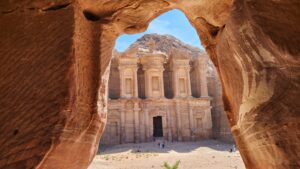
| Objective: So Much to See in Petra Distance: 8.4 miles (out and back) Peak Elevation:1,838′ Difficulty: Moderate Red Tape: Fee to enter Petra |
Petra is one of the modern Wonders of the World. The canyons within the Wadi Musa contain a Main Trail and multiple offshoots from where you can explore the ancient city of Petra in Jordan. There is so much more to see in Petra beyond the Treasury. At a minimum, you should also check out the Monastery and the Royal Tombs. Spend at least one full day in Petra and explore some of the side trails.
Al-Siq | The Treasury | The Monastery | Royal Tombs | Video Tour
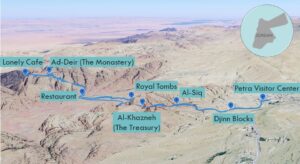
Directions
| Petra Visitor Center: From the Petra Visitor Center, begin walking on the Main Trail. 0.43 miles: The Djinn Blocks are to the north. 0.70 miles: The Main Trail enters Al-Siq. 1.40 miles: The canyon reaches an intersection of valleys where the Treasury is located. 1.65 miles: After the Street of Facades, a trail to the south leads to the High Place of Sacrifice. At the junction, keep heading straight to stay on the Main Trail. 1.79 miles: After the Nabatean Theatre, the Al-Khubtha Trail heads north to the Royal Tombs. At the junction, keep left to stay on the Main Trail. 1.90 miles: As the trail turns to the west, the canyon opens into a flat space. After 0.25 miles, continue along the Colonnaded Street north of the Great Temple. 2.56 miles: The restaurant here is a good spot for lunch on the way down from Ad-Deir. Head north on the Monastery Trail. 3.50 miles: At the top, you have reached the Monastery a little to the north. 4.20 miles: At the Lonely Cafe, turn around and head back. On your return, explore any of the side trails as you see fit. |
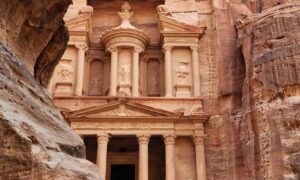
Heading into Al-Siq
From the eastern entrance by the Petra Visitor Center, there is one main path heading west into the canyon. The sandstone cliffs are pink with interesting natural eroded shapes. Then, engineered stone structures soon come into focus. The Djinn Blocks are square funerary monuments that seem to point the way for more to come.
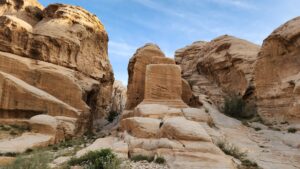
Al-Siq looks like a slot canyon, but it is the result of the mountain splitting open, rather than from erosion. The Nabateans cleverly built aqueducts channeling water through the Wadi Musa (or Valley of Moses) to Petra. Enjoy the paved and mostly shaded path through Al-Siq. Light streams in through the top and you can see the occasional tree clinging high above.
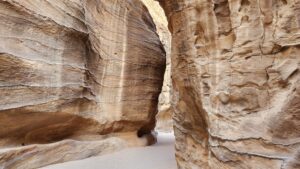
Al-Khazneh (the Treasury)
From around the corner, the narrow canyon reveals first glimpses of the impressive Al-Khazneh (the Treasury). The Nabateans were an advanced engineering and mercantile civilization who controlled the key trade routes of the ancient world. The Nabateans cut and chiseled the colossal pink facade out of the rock wall. It was the mausoleum of King Aretas IV from the 1st century. Most cultures build monuments. The Nabateans carved monuments out of the mountainside.
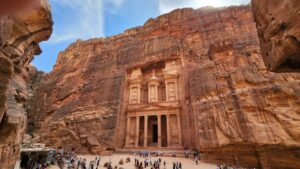
For 5 Jordanian dinars, you can pay a guide to let you climb the rock stairs to a precarious perch above and across from the Treasury. From here, you can take the best photos. You may remember this as the hiding spot of the Holy Grail from Indiana Jones and the Last Crusade. Unlike the movie, you cannot go inside and it does not open into hidden booby-trapped chambers.
As you continue within the canyon, you walk by the Street of Facades. These tombs resemble the Treasury with facades also cut into the rock face. But the Nabateans never finished some of the tombs and the elements have eroded the rest.
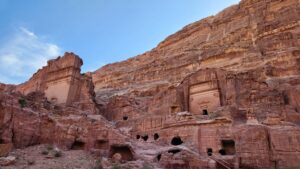
Near the end of the canyon, the Nabateans carved the Theatre into the cliffs providing decent seats for viewing the tombs. We are provided a demonstration of camel sand art in a bottle.
Petra opens into a large flat open space at the center. The main Colonnaded Street was the central trading and shopping street for traveling merchants. Near the end of the street, the Great Temple has an imposing staircase rising to this sacred seat of power.
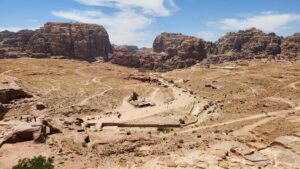
Ad-Deir (the Monastery)
There is a restaurant serving as a central nexus connecting many of the trails in Petra. From this hub, take the northeast trail leading to the Ad-Deir (the Monastery). The path begins climbing right from the start. The stone staircase curves around vendor stalls and follows a few light switchbacks.
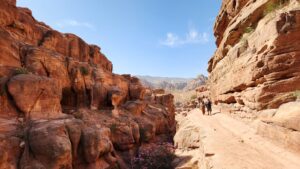
After a while, the path reaches the top of the canyon. Looking back, from a rocky outcropping, you have a nice view of the canyon.
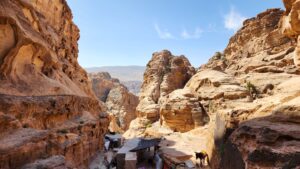
Eventually, you reach the commanding spot of Ad-Deir (the Monastery) on a plateau. The Monastery does not reveal itself in as dramatic fashion as the Treasury, but it is much larger.
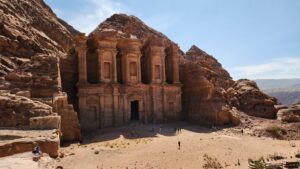
Once you are at the Monastery, you can gawk and take a bunch of pictures. Or you can walk up to a cave and take photos. If you like, you can climb to a higher bump for a higher view of the Monastery. Each bump seems to have a carpet with a shaded teahouse. At another bump, a Bedouin resembling Captain Jack Sparrow from Pirates of the Caribbean with black eyeliner plays a flute.
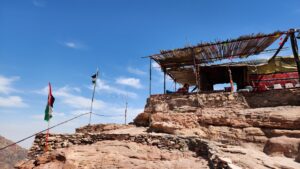
From here, you can look at the green mountains and valleys beyond.
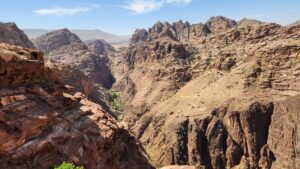
Opposite the Monastery, there is a rest stop in a cave where you can have refreshments, sit in a cushioned seat, lounge next to a kitten, and soak in the majestic views.
Walk back down to the flat area with the restaurant. This is the best and only spot for lunch, where you can get a chicken shawarma wrap and a soda.
Royal Tombs
On a rock shelf, the Royal Tombs demonstrate power from an imposing perch. Through years of erosion, the stone in the facade of the Palace Tomb looks like it has melted.

The Urn Tomb has columns in the side recesses and a large front court. Inside the tomb, the Nabateans created a flawlessly carved rectangular room. Seeing the amount of rock that was once hand chiseled is extraordinary. The walls, ceiling, and floor are perfectly level. The corners are at perfect right angles. However, the surfaces are not smooth. You can see the chisel marks and grooves on the stone. Stepping out of the tomb and into the court, this may be the best view in all of Petra.
As you head back, there are many other paths and places to see. When you return to the Treasury, it is nice just to sit below and observe the grandeur. Before you leave the Treasury, there is a small ledge on the southeast side that you can reach with some light scrambling. It isn’t too easy to find, but it’s one of the best spots in Petra.
